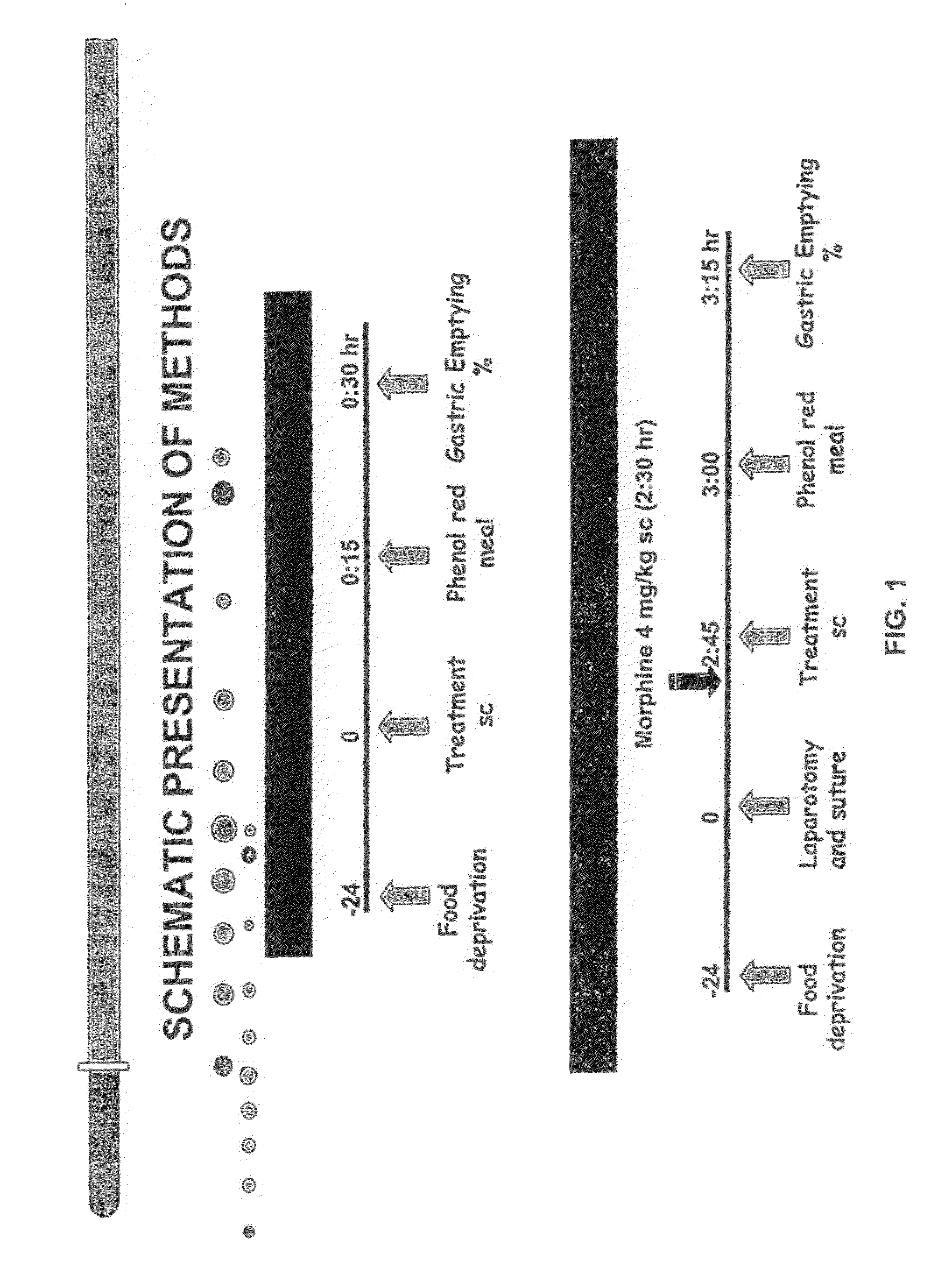Compositions and methods for stimulating gastrointestinal motility
a technology of gastrointestinal tract and motility, which is applied in the direction of anti-obesity medical ingredients, peptide/protein ingredients, and obesity gene products, etc., can solve the problems of prolonging hospitalization, not only preventing normal resumption, and foster postoperative complications
- Summary
- Abstract
- Description
- Claims
- Application Information
AI Technical Summary
Benefits of technology
Problems solved by technology
Method used
Image
Examples
example 4
(Cys3(S-Decyl))hGhrelin(1-28)-NH2 (SEQ ID NO:1)
[0249](i) The titled peptide was synthesized according to the procedure described in Example 3 for the synthesis of (Glu3(NH-Hexyl))hGhrelin(1-28)-NH (SEQ ID NO:1) with the following modifications: After the assembly of the first 25 residues using Boc chemistry, the last 3 residues were assembled by employing Fmoc chemistry. The following 3 Fmoc amino acids were used: N-α-Fmoc-S-(p-methoxytrityl)-L-cysteine (Fmoc-Cys(Mmt)-OH), Fmoc-Ser(Bzl)-OH and Fmoc-Gly-OH, which were purchased from Novabiochem (San Diego, Calif.). The Fmoc amino acid (1 mmol) was first pre-activated with HBTU (0.9 mmol) and HOBt (0.9 mmol) in DMF before it was coupled to the peptide-resin. The synthesis cycle for the Fmoc amino acids included: (1) washing with NMP, (2) removing Fmoc protecting group with 20% piperidine in NMP for 30 min, (3) washing with NMP, and (4) coupling with pre-activated Fmoc amino acid for 1 h.
[0250](ii) At the end of the assembly of the ent...
example 1
H-Apc-D-1-Nal-D-1-Nal-Phe-Apc-NH2 (SEQ ID NO:129)
[0256]Each of the reaction wells contained 0.0675 mmol of Rink Amide MBHA resin (substitution=0.72 mmol / g, Novabiochem, San Diego, Calif.). The following Fmoc amino acids (Novabiochem, San Diego, Calif.; Chem-Impex International, Wood Dale, Ill.; SyntheTech, Albany, Oreg.; Pharma Core, High Point, N.C.) were used: Fmoc-Lys(Boc)-OH, Fmoc-Phe-OH, Fmoc-H-Inp-OH, Fmoc-D-1-Nal-OH, Fmoc-D-2-Nal-OH, Fmoc-D-Trp(Boc)-OH, Fmoc-3-Pal-OH, Fmoc-4-Pal-OH, Fmoc-Orn(Boc)-OH, Fmoc-D-Bip-OH, Fmoc-Thr(Bzl)-OH, Fmoc-Pff-OH, Fmoc-2-Thi-OH, Fmoc-Taz-OH, Fmoc-D-Dip-OH, Fmoc-D-Bpa-OH, Fmoc-D-Bal-OH, and Fmoc-Apc(Boc)-OH.
[0257]Each of the Fmoc amino acids was dissolved in a 0.3 N solution of HOBt in DMF wherein the concentration of the resulting Fmoc amino acid was 0.3 N. A four fold excess (0.27 mmol, 0.9 mL of the 0.3 N solution) of Fmoc amino acid was used for each coupling. DIC (0.27 mmol, 0.6 mL of 0.45N DIC solution in DMF) was used as the coupling reag...
example 2
H-Inp-D-2-Nal-D-Trp(Ψ)-Pim (SEQ ID NO:126)
[0260]1.a. BOC-(D)-Trp-OH (4.0 g, 13.1 mmole) (Novabiochem San Diego, Calif.) in methanol (36 ml) and Cs2CO3 (2.14 g, 6.57 mmole) in water (10 ml) were combined and the mixture was swirled until a homogeneous mixture was obtained. Solvents were removed in vacuo and the residue was dissolved in DMF (45 ml). 2-bromoacetophenone (2.61 g, 13.1 mmole) in DMF (9 ml) was added to the solution and the solution was stirred for 30 min. at room temperature. Cesium bromide was removed by filtration and the filtrate was concentrated in vacuo. The resulting concentrate was dissolved in xylenes (45 ml), NH4OAc (17.1 g) was added, and the solution was heated at reflux for 1 hr. The cooled solution was washed two times with saturated NaHCO3 solution (45 ml) and then with saturated NaCl. The resulting organic layer was purified by flash chromatography to yield 4.1 g (77%) of intermediate 1A depicted in Scheme 1A, (“Compound 1A”).
[0261]
1b. Compound 1A (403 mg)...
PUM
 Login to View More
Login to View More Abstract
Description
Claims
Application Information
 Login to View More
Login to View More - R&D
- Intellectual Property
- Life Sciences
- Materials
- Tech Scout
- Unparalleled Data Quality
- Higher Quality Content
- 60% Fewer Hallucinations
Browse by: Latest US Patents, China's latest patents, Technical Efficacy Thesaurus, Application Domain, Technology Topic, Popular Technical Reports.
© 2025 PatSnap. All rights reserved.Legal|Privacy policy|Modern Slavery Act Transparency Statement|Sitemap|About US| Contact US: help@patsnap.com



